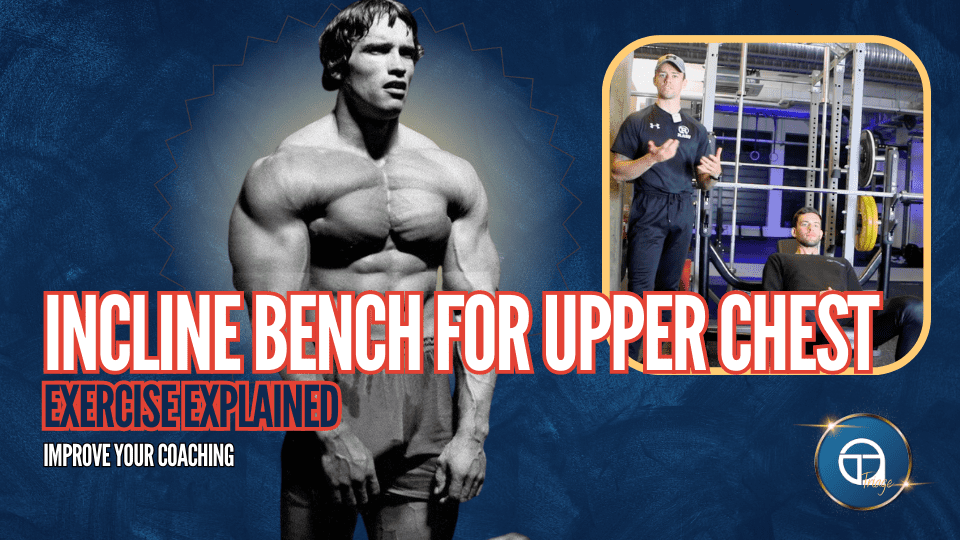Most people are generally aware that when we want to train the upper pec, the clavicular part of the pec, you are probably going to be told that you should be using the incline bench press, or at least some sort of incline pressing variation. This is generally sound advice, however, you do still actually have to pay attention to how you’re setting up the exercise, who the individual is in front of you, and what angle you’re actually working with. Because if you have someone who performs the exercise with a big massive arch in their back, and especially if they also do what a lot of people do and shift the bum forward a lot, then they will now be in a position where they are basically more or less performing a flat press. Despite being on the incline bench, they have contorted their body so the lower pec region is still going to be doing a lot of the work here.
And that’s one of the key things to recognize when you’re talking about flat versus incline versus decline. It’s not just about changing the bench angle that changes the muscles that are working; it’s about the interaction between the individual, the exercise setup, and their actual intent. That’s a really important thing to get here. If we’re going to be using the incline bench press for upper pec development, then what we might need to do for one client might be different from what we need to do for another.
So how should you be thinking about setting up the incline bench press so that you can actually build the upper chest musculature effectively?
Using The Incline Bench Press For The Upper Chest
When we have someone who wants to build the upper chest, or who wants to start using the incline bench press to develop the upper chest, then we do have to start to think about all the variables that will make or break that being a good exercise for that specific goal. For example, for some people, having a 60-degree incline may result in a better upper chest stimulus, but for someone else, they might just need a 30-degree incline. And that’s going to depend on how much they can arch their back and the actual shape of their chest in general.
In general, most incline bench press benches are at a 30-degree incline. So, if I’m trying to get someone to set up in such a way that they’re really trying to bias the upper chest, then I don’t necessarily want them to arch so much that they get totally out of that incline. Now some arching might be fine, and it doesn’t necessarily make too much of a difference for most of our general population clients, but for people with specific goals who are doing specific exercises for that purpose, we might want to pay attention to that.
Another key part here is that when we start to think about how we’re using an incline bench press, we must consider the actual function of the muscles involved. The purpose of the pectoralis major, especially the upper part, the clavicular head, the function of that muscle is not just to bring the arm across the body when you’re at an incline. Rather, it has more of a function whereby it brings the arm up and across the body. So, if you have your arm down by your side, and you then try to bring that arm towards your opposite ear, you’re going to find that the upper part of the pec starts to work a lot more than it does if you just bring it across the body.
You’re going to feel a kind of shortening; you’re going to feel it working. But the key thing here is that if you can start to also bias the path of the arm, that’s really when you’re going to start to get a little bit more out of that pec muscle, especially that upper part. So what I would say here is that if you’re trying to use an incline bench and you’re trying to really bias the upper pec, another thing that you can start to do is play around with the path that you’re actually using in terms of your movement trajectory, your bar path. You can also play around with your arm path by tucking the elbow a little bit, so we’ve got a smaller angle between the body and the arm, and as a result, to press the bar, you can actually bring the arm up and across rather than just out and in. This will result in you feeling the upper part of the pec more.
Now, do I advise people immediately go and do that with an incline bench press? Not necessarily. For the most part, I’m kind of happy for people to let the incline do the bit of work and choose the arm position that they’re most comfortable with. However, you can take lessons from what we just showed there and apply it to things like dumbbell exercises. So, if you were doing an incline pressing variation but you were doing it with dumbbells, you have more freedom to move around with your arm path, and that might be something that’s actually worth considering for you then.
So although that applies theoretically, it does apply in terms of moving around the path of the arm in general. When I’m getting someone to do this, I’m more focused on taking the kind of elbow position that they’re most comfortable with and then using the intent to change the emphasis a little bit.
If I have a client that is really trying to emphasize the pec, then I am not just going to have them move the bar mindlessly up and down. I want them to think about sliding their hands in towards each other throughout the repetition. Even in that top position where many people stack the joints and take a bit of a rest, I want them thinking “hands in, hands in.” This way we’re trying to focus more on the chest and less on just the movement itself. Because sometimes that might be giving the person the sensation that it’s all on the shoulders, which isn’t what we want.
Keep these things in mind when you are using the incline bench press to target the upper chest. However, as I said, it doesn’t mean you have to go into that much detail with every single client, because for many of our clients, they just come in, they want to build a bit of muscle, a bit of strength, they hop on the incline press, it all feels good, and that’s absolutely fine. We don’t need to be excessive with our exercise execution. However, for some individuals, you might need to do that little bit of customization and use some additional cues, especially if someone is saying, ‘I’ve been doing bench presses for years, never feel my chest working, and always find that my shoulders are getting aggravated.’ That’s where you start to look at those variables, and that’s how you become a coach who’s actually applying personal training, personalizing for the individual, rather than just handing out choreography and recipes.
If you enjoyed this, we do have lots of content on our YouTube channel which you might also enjoy. We do also have coaching spaces available, if you really want to get your own training and exercise execution dialled in.

Gary McGowan
Hey, I am Dr Gary McGowan, co-founder of Triage, qualified Doctor, Physiotherapist, and Coach.
Having graduated with first class honours in Physiotherapy (BSc) and Medicine (MB BCh BAO), I aim to blend medical science with a decade of coaching experience to help you maximise your performance, transform your body, and optimise your health.
I enjoy grappling, hiking, lifting, and other modes of physical training. When I’m not training, I like to read broadly, particularly philosophy, religion, and history. I love the natural world, particularly the mountains & lakes of my hometown Killarney, County Kerry.


